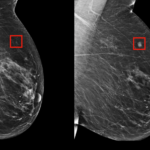 One of the most common applications of AI in healthcare has been in analyzing medical images to provide earlier diagnoses of various conditions. The latest project of this kind has recently emerged from MIT’s Computer Science and Artificial Intelligence Laboratory (CSAIL), who have developed a deep learning model that can predict the likelihood of breast cancer up to five years into the future.
One of the most common applications of AI in healthcare has been in analyzing medical images to provide earlier diagnoses of various conditions. The latest project of this kind has recently emerged from MIT’s Computer Science and Artificial Intelligence Laboratory (CSAIL), who have developed a deep learning model that can predict the likelihood of breast cancer up to five years into the future.
The system was trained using mammograms from over 60,000 patients for whom the outcome was known. The idea was to train the system so that it could spot the subtle patterns in breast tissue that ultimately lead to tumors emerging.
“Rather than taking a one-size fits all approach, we can personalize screening around a woman’s risk of developing cancer,” the team explain. “For example, a doctor might recommend that one group of women get a mammogram every other year, while another higher-risk group might get supplemental MRI screening.”
Screening improvements
The model proved to be significantly better than existing methods, and was able to accurately place 31% of all patients into the highest-risk category. Existing models are able to do so only 18% of the time. This is largely because of their focus on risk factors rather than age, which is something the medical community have largely veered away from.
“This is because before we did not have accurate risk assessment tools that worked for individual women,” the team explain. “Our work is the first to show that it’s possible.”
What is equally interesting is that the system was accurate regardless of the ethnic background of the participants. Many of the early models used for screening were developed on white populations, and are therefore less accurate for other races. This is a vital flaw as black woman are believed to be around 40% more likely to die from breast cancer, which makes early detection vital.
“It’s particularly striking that the model performs equally as well for white and black people, which has not been the case with prior tools,” the researchers explain. “If validated and made available for widespread use, this could really improve on our current strategies to estimate risk.”
The ultimate goal of the project is for such AI-driven screening to become a standard part of the care people are given. The team are confident that their system is both clinically robust and valuable enough for this to ultimately happen, although the path to market is notoriously lengthy in healthcare. Nonetheless, it’s an interesting example of the progress being made in the field.